Welcome to our guide on types of roses for choosing the perfect roses for your lawn and garden.
Do you feel like MISSING something when planting the SAME ROSE every year? I know this FEELING of wanting something unique for your garden.
Don’t worry, fellow GARDENER! At AsterGardening, we know how you feel about these ROSES. Explore our EXCLUSIVE range of roses from over 150 species.
Isn’t it SOMETHING that you want to look into? Our ultimate guide is there to FEED you with some Rosey KNOWLEDGE.
You are going to EXPLORE different shrub roses. Ultimately, you can decide the best ROSES to plant in your GARDEN.
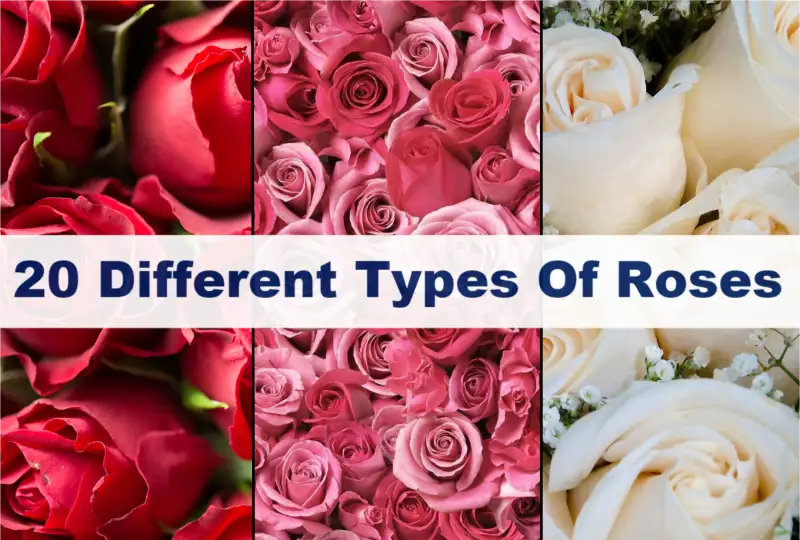
Description and Use of Roses
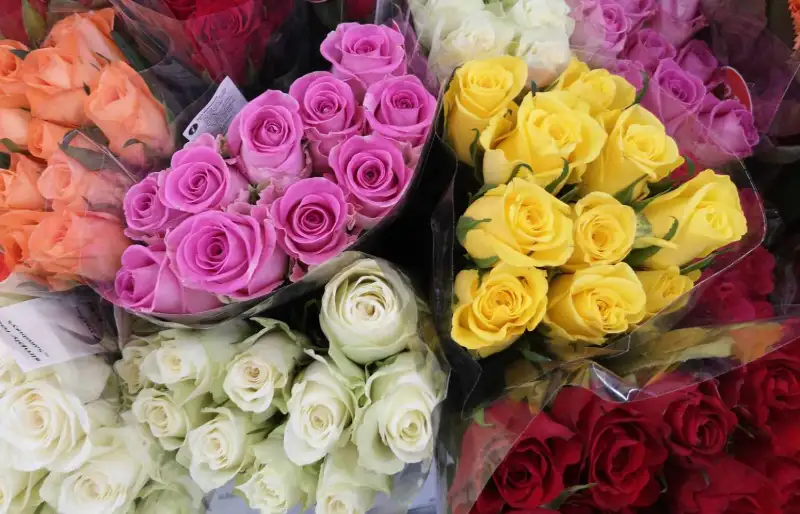
WHO doesn’t know about the ROSES? They are EVERYONE’S favorite for their timeless and classic vibes.
What if I tell you these BEAUTIES are much more than you know? You heard me right!
Roses are one the FINEST flowers from the Rosacea FAMILY. Don’t want to learn the TECHNICALITIES? Let’s explore more!
They are from worldwide, including Asia, Europe, and North America. Thinking about why they have such a huge cluster of habitats?
Listen, my FRIEND! There are HUNDREDS of rose species. So TECHNICALLY, they can be grown everywhere.
Every rose has its unique characteristics and features. Unique enough to make you fall in love with their BEAUTY.
Some have a straightforward plant that exhibits CANE-LIKE rambling long stems. Others have beautiful BLOOM to give your lawn an INCREDIBLE look.
With their PERFECT indoor and outdoor compatibility, shrub roses are best for ornamental purposes.
Not alone, they are for BEAUTY purposes. There is much MORE to it.
These are extraordinary for their fragrance and medicinal use. People have been using it for COMMERCIAL cut flowers and PERFUMERY for ages.
20 Different Types of Roses
HEY THERE, gardeners and homeowners! Check out the types of roses to help add a DIVERSITY to your rose world.
1. Old Garden Roses
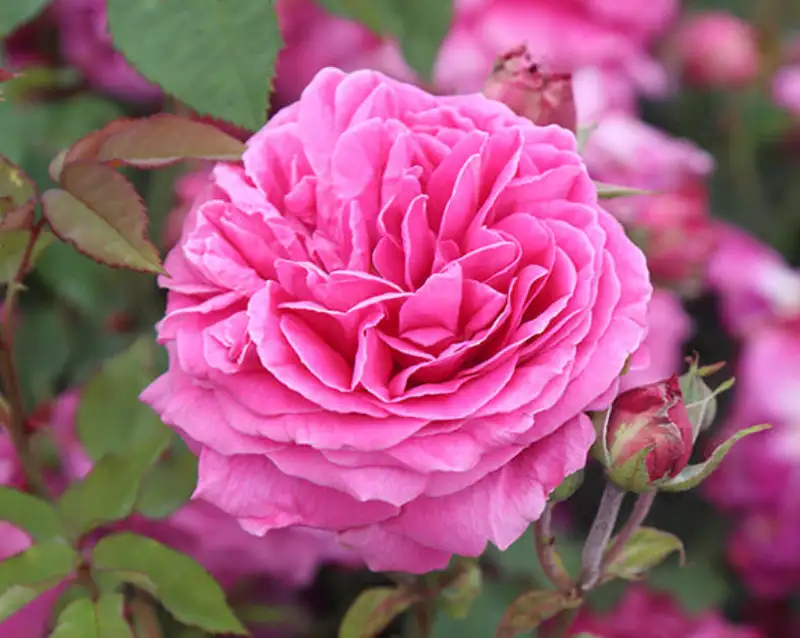
Old garden roses EXISTED before 1867. More than 80% of modern roses are bred from old garden roses.
There ARE 5 MAIN CATEGORIES of these old garden roses. They include Gallicas, Damask, Moss, Alba, and Centifolia.
Old garden roses plants prefer a hardiness zone around 3-5. These European roses do better in COOLER zones and suffer in ZONE 7 or higher.
Old garden roses have extreme WINTER HARDINESS. They have excellent TOLERANCE and disease-resistant character.
They have a beautiful bloom throughout the summer. They deliver outstanding FRAGRANCE during their blooming season.
2. Wild Roses

Wild roses are usually purplish to pink and always contain DARK and DEEPER colors.
The mature size of wild roses ranges from 3 to 5 feet, and the Hardiness Zone ranges from 5 to 9.
Wild Rose needs full SUNLIGHT to have a perfect BLOOM. The soil needs to be well-drained and loamy. The fragrance is quite strong, with a hint of citrus.
You cannot call it a true blue rose as its maximum bloom size never reaches high from 3 INCHES.
The showy flowers of this wild rose appear in large clusters. They have several PETALS on the BLOSSOM.
3. Hybrid Tea Roses

Do you WANT to FILL your garden with large and pointed buds? TRY Hybrid Teas.
I ADORE Hybrid Tea Roses, especially the two-tone varieties, for decorating outdoor gardens. Do WANNA know the reason? Its APRICOT and TEA color petals perfectly fit a rose garden.
Hybrid Tea roses also go by the fragrant cloud name. The intensely SWEET and SPICY fragrant earned it the name.
You can grow Hybrid Tea roses for the border and edges in full sun. The 5 to 6 feet TALL height makes it perfect for growing for the borders.
My EXPERIENCE with Hybrid Tea roses is never boring. These USDA zones 6 to 11 plants like WELL-DRAINED and ENRICHED soil.
4. Floribunda Roses
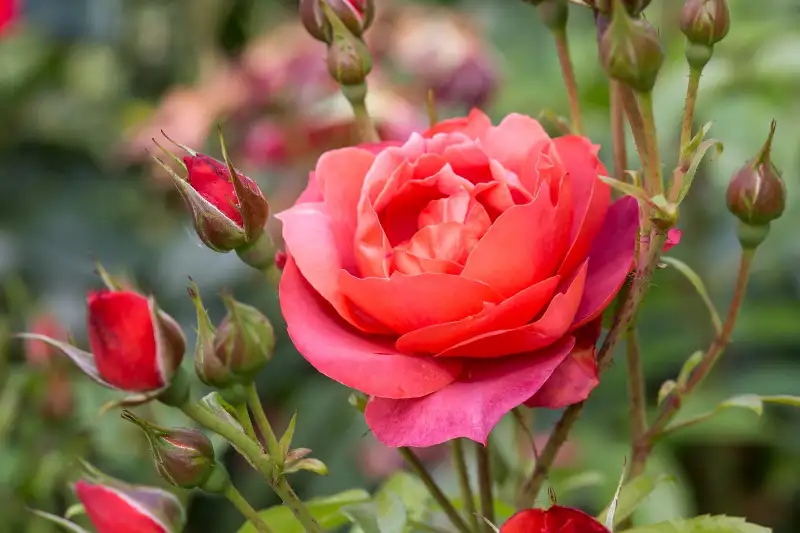
Are you a fan of classic rose varieties? Why not TRY Floribunda Roses? The fresh and pretty color makes them GLOW hence named Butter gold.
The cluster of flowers on Floribunda roses SATISFIES your daily need for roses. This is how they grow and make the whole garden smell like sweet licorice.
However, there’s MORE to these roses than just that. You can plant them in a BUSHY habitat.
Oh! How can I miss care tips? Given the FULL sun and well-drained soil in zone 6 to 11. You will LOVE them when they grow 2 to 3 feet TALL.
5. Groundcover Roses

Ground Cover Roses are one of the few RECOMMENDATIONS that you will HEAR from VETERANS. These garden roses make you feel like heaven.
So what is UNIQUE about them for being this FAMOUS? This 3 feet tall low-growing shrub can SINGLE or DOUBLE blooms.
I have them planted to make the lawn fancy and tidy. Groundcover roses produce LOVELY white, red, yellow, and deep pink FLOWERS.
The FUN part is that these HARDY roses can SURVIVE from late spring to winter. You can have enough time to GROW them before FROST.
I HIGHLY RECOMMEND them for their low maintenance. Moreover, USDA hardiness zones 4 to 11 are PERFECT for growing them.
6. Alba Roses
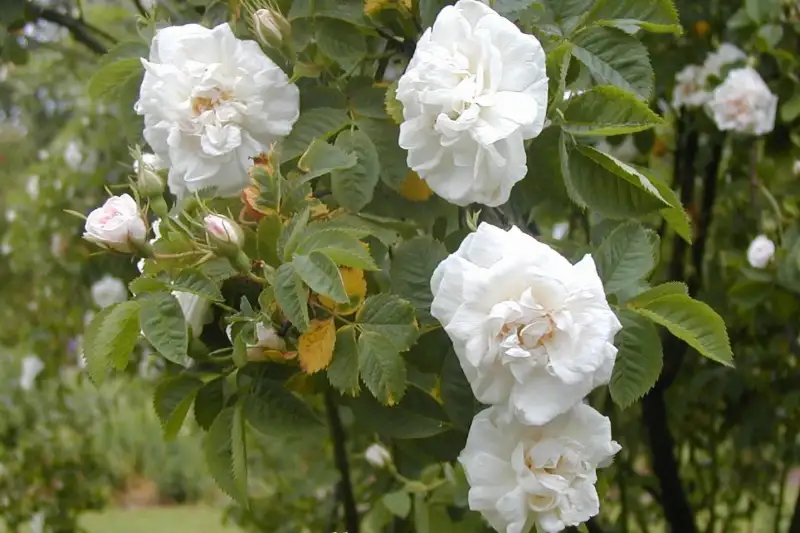
If you are talking about the TOUGHEST growing FLOWERS, they are one of them. These flowers are always white or pale pink. They contain a PUNGENT and INTENSE aroma.
Alba roses are native to England and Northern Europe. Their special characteristics include DISEASE RESISTANCE and TOLERANCE.
The white rose or alba rose contains a multi-layered growth. Each bloom comprises FORTY PETALS, double the number of common roses.
Their hardiness zone is winter hardy near USDA zone 2, where the temperature is below -50 degrees. These roses grow in TIGHT SPACES, all petals grown on one another.
7. Bourbon Roses

They resemble those Damask and China roses as the CROSS between these two plants. These bourbon roses got introduced in France in 1817.
Bourbon roses contain amazing FULL BLOOMS, and you will find different shades of pink. The white, red, and deep pink combination produces an impeccable bourbon color rose.
Do you want to ATTRACT fairies to your modern GARDEN roses? Plant these little BEAUTIES. They carry an intense and heady aroma.
A MATURE plant can grow to almost 5 to 8 feet TALL, which is impressive. You can GROW them in USDA zone 4 as they can tackle EXTREME winter like a boss.
8. Centifolia Roses

The Centifolia Roses are PERFECT if you like cabbages and pink color. The REASON they are also CALLED Cabbage roses.
Can’t relate? Well, these roses have GLOBULAR shapes and closely packed petals. The PINK color on them makes them shiny yet fragrant flowers.
The modern roses, standing 3 to 5 feet tall, blossom in a delightful BLEND of white and pink hues.
Talk about diversity! You can find several CATEGORIES of these flowers. New hybrids are STUNNING with their purple, deep purple, red, and maroon SHADES.
I find them best performing in USDA zone 5 to 9. Take TWO CENTS and grow them in early summer. You will LOVE it!
9. English Roses
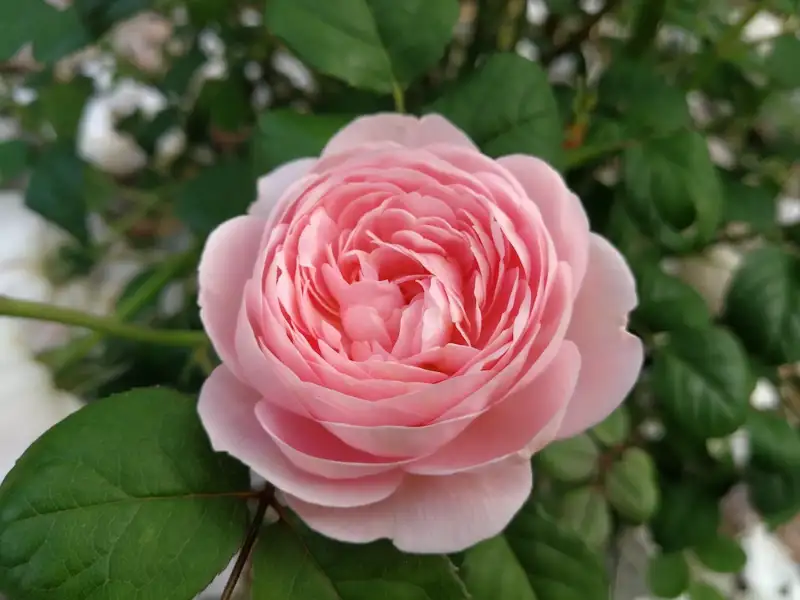
English Roses are a PERFECT choice if you want to repeat BLOOM of flowers.
Do you know what BONUS comes along? They got a strong fragrance to make your lawn smell HEAVENLY.
These MODERN roses are a SUCCESSFUL cross of OLD and MODERN roses. The fragrance of OLD roses lingers in the repeated blooms of new roses.
The BEST part is that it does have HABITAT variations. These ROSES are ENDEMIC to Asia and some parts of Europe.
They can grow 1 to 3 feet tall in part sun to full sun. Make them HAPPY and grow them in USDA zones 5 to 8. You won’t REGRET it!
10. China Roses

China roses or Rosa chinensis are UNDERCOVER rose agents NATIVE to China and East Asia. Get it! These pink beauties are gonna steal your heart.
China Rose is your PERFECT lawn partner if you don’t like INTENSE fragrances. But you will get a disease-resistant variety at the cost of fragrance.
Do you know why I find them unique? I use them as a stock PARENT for new HYBRID roses. A perfect GIFT for my inner scientist!
They have a DECENT fragrance with SMALLER and more COMPACT blooms. These repeat bloomers in early summer till fall arrives.
They GROW to a maximum HEIGHT of 6 feet in USDA zone 7a to 8b.
11. Damask Roses

Among the oldest roses are the Damask roses, rooted in biblical times. They are NATIVE to the Middle East.
You can discover two kinds – summer damask and autumn damask. The AUTUMN damask blooms TWO times yearly, in SUMMER and FALL.
You will find a wide variety of COLORS as there are bright SILVERY white to deep PINKS.
I found them the PERFECT choice for a fragrant scent. You can EXTRACT them and use them as an ESSENTIAL oil in perfumes.
Damask roses grow to a maximum HEIGHT of 5 to 8 feet. Their HARDINESS ZONE ranges from 4b to 9b.
12. Gallica Roses

The NAME may seem GIMMICKY, but Gallica roses are REAL. They are ancient roses older than the 12 century.
So what makes them FAMOUS? They have a rare and decent fragrance that is an ESSENCE for perfumes.
Not ONLY this, Gallica Roses are medically important. The REASON is inside their petals. These beauties have ANTIBACTERIAL properties. Talk about VERSATILITY!
These roses come in BLOOMS with a variety of shades. To BEAUTIFY your garden, you can plant them to get red, purple, and pink SHADES.
The two tonal purple roses are NATIVE to Southern and Central Europe. Don’t WORRY! You can plant them in USDA zones 3 to 9.
13. Miniature Roses
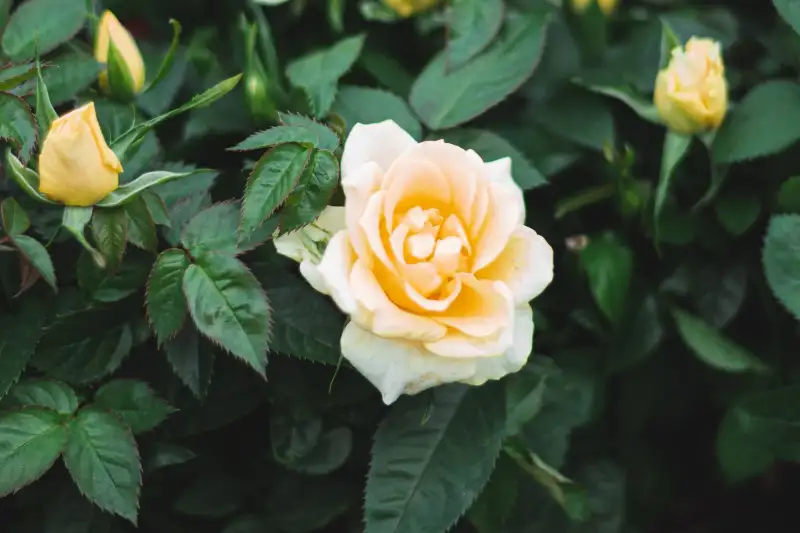
You may have HEARD that small things make a BIG difference. That’s TRUE for these miniature roses.
These roses are a hybrid of Tea and Grandiflora roses. Hence, they CARRY the features of BOTH varieties.
What makes them UNIQUE is their SMALL size. Miniature rose is small enough to GROW inside pots and containers. You can grow it to a SIZE of 15 to 30 inches.
Need a COMPARISON? They can bear an intermediate-sized flower BLOOM. That is close to the size of FLORIBUNDA.
Miniature roses are NATIVE to Asia but can grow in USDA Hardiness zone 4 to 11. Cultivating these modern roses in LAWNS and GARDENS is a perfect way to showcase their beauty.
14. Knock Out Roses
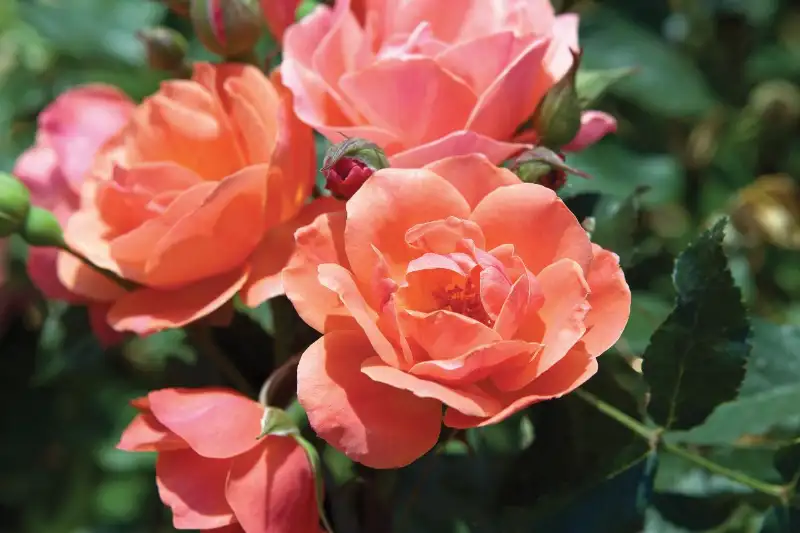
Knockout or rainbow knockout rose is a SHRUB with a CLASSIC single flower. These roses belong to the SHRUB type and are a commonly occurring species.
They have an excellent rebloom cycle and APPEAR in clusters and yellow centers. Their FOLIAGE is dark green and semi-glossy.
They grow in hardiness zone 4 to 9. Unlike the RECOMMENDATION, I have grown them OUTSIDE these zones. Surprisingly, they survived, but care is needed.
Knockout roses have a MATURE size of 3 to 4 feet. They need full exposure to the sun for perfect growth. The soil needs to be FERTILE and WELL-DRAINED.
15. Climbing Roses

Climbing roses is not a PROPER class. It is similar to Floribunda and Grandiflora regarding characteristics.
They are famous for climbing roses but cannot climb BETTER than vines. You can also call them rambling roses.
A Climbing rose has a STURDY and UPRIGHT cane that provides SUPPORT to its surroundings. I recommend them for SUPPORT plants for lawn shrubs and vines.
These modern roses can grow to a MAXIMUM height of 15 feet. They reach the height of garden fences, pergolas, arbores, and trellis.
Climbing roses have a hardiness zone around 5 to 9. They tend to grow BETTER in a location with LOTS of suns.
16. Canadian Roses
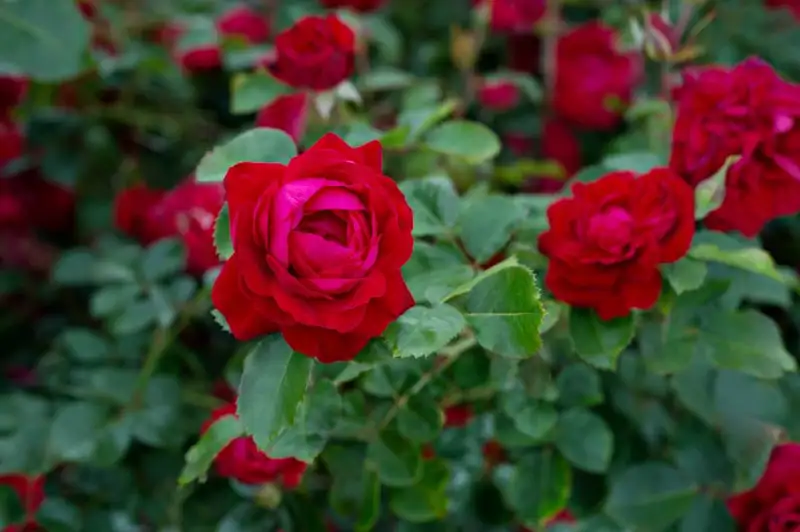
Do you want to know a GREAT option for your modern GARDEN roses collection? Canadian Roses! They’re TOUGH as nails and PERFECT for growing in USDA zones 3-7.
They are HYBRID of wild roses from Canada with FANCY roses from Europe and Asia.
They come in various colors, including bright pink, red, and white. Check this out: these repeat BLOOMERS will keep your garden GLOWING all season!
For best results, I love to PLANT them in well-draining soil. They love SUN or partial SHADE to thrive.
Plus, they can HOLD their own against lots of common rose diseases. So, you don’t have to FUSS over them too much.
17. Polyantha Roses
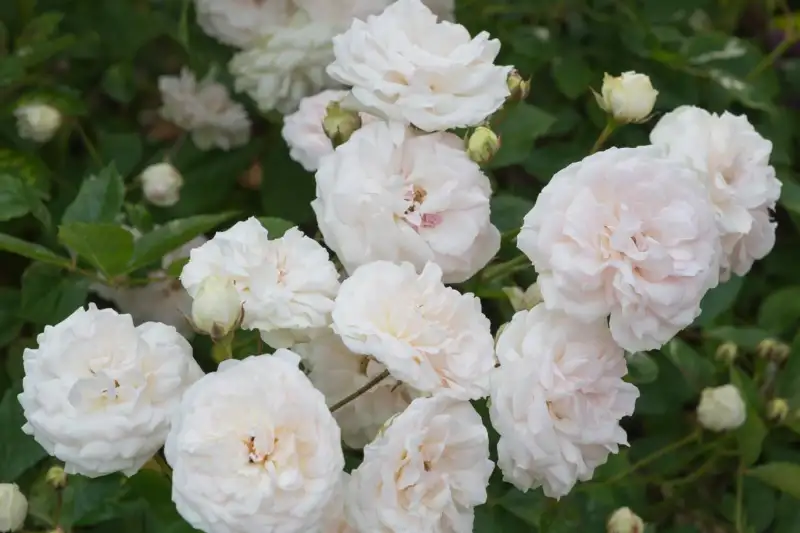
Polyantha roses are shorter and smaller. You might use polyantha for EDGING and HEDGES. As they are PERFECT for backyard landscapes.
You will find these rose bushes COVERED completely with CLUSTERS of small flowers. They have a prolific bloom that stays with you from late Spring to Fall.
Polyantha roses are NATIVE to East Asia. These roses have a hardiness zone from 4 to 9.
They have a maximum HEIGHT of 1 to 3 feet as they are small and COMPACT rose types. I have planted them in containers and pots due to their space-saving nature.
18. Rambling Roses

While modern types of roses seem identical to climbing varieties, they are different. These roses are more DYNAMIC and BLOOM ONCE a year, starting early summer.
I tried mixing them with Climbing Roses to take some initial support. Surprisingly, these have GROWN into beautiful plants.
They take up EVERYTHING that comes their WAY. It is better to coax a path for them to give track of their growth.
These roses grow very TALL; if you keep them with CARE, they can grow to 20 feet. The hardiness zone ranges from 8 to 10, requiring LOTS of sun.
19. Shrub Roses

The maximum HEIGHT of shrub roses ranges from 5 to 15 feet as they SPRAWL. They are a hardy, low-maintenance, and versatile type of rose.
Most shrub roses are HARDY in USDA zones 3-9. They are NATIVE to North America, Europe, Asia, and Africa.
Hey you! Want to know their specialty? They can WITHSTAND harsh weather conditions like a champ.
Their strong fragrance and disease-resistant nature are accompanied by a prolonged blooming period. Talk about some STRONG roses!
They don’t need much pruning or fertilizing. And can be PROPAGATED easily by cuttings or layering.
20. Noisette Roses

There you have the LAST one. Noisette roses are NATIVE to South Carolina and are a beautiful and hardy rose species.
What makes them GET a place on the LIST? Two things: long-lasting fragrant blooms and robust disease-resistant dark green foliage.
Growing them is not ROCKET science. They thrive well in USDA hardiness zones 7-9. Provide them with Full sun, and they can reach heights of up to 8 feet.
It’s my IDEAL choice for GARDENERS looking for new rose opportunities. The heat and drought tolerance make them a perfect fit for any lawn.
Why not give it a TRY and up your LANDSCAPE game?
FAQs about Types Of Roses
1. How many rose varieties are there?
The reported rose varieties are more than 150 in number. This figure is increasing with time due to new hybrids. Thousands of rose varieties suitable for gardens and lawns have been estimated.
2. What is the most famous rose type?
Modern Hybrid Tea Rose is the most famous among all the rose types. It has a very strong fragrance that makes it a perfect choice for gardens. Hybrid tea rose blooms are large, providing cut flowers and bouquets.
3. What is the most difficult rose to grow?
Gallica and Alba are one of the most difficult to grow. They are not disease-resistant and can acquire powdery mildew and black spots. Caring for them through regular pruning and soil amendment is a must.
4. What is the most unique rose?
The black rose is the most unique rose due to its color pigmentation. It has a dark color which is rare in nature. Only a few plants can carry the pigments that make them unique. Challenges like disease and care patterns make their habitat limited.
What’s Next
Ready for a quick WRAP UP? Roses are the symbol of love, passion, and fragrance. There is a rose in DIFFERENT shapes, sizes, and colors for every OCCASION.
This article lists 20 different types of roses. You have LEARNED about their care tips, growing habitat, and special characters.
They are a great WAY displaying affection to others and can bring a SMILE to their face. With the numerous types of roses, there is one for everyone and any SPECIAL occasion.
If you are WONDERING about different TYPES of roses, their names, and special features. Don’t WORRY. We’ve got you COVERED!
AsterGardening is perfect for EXPERT advice and SOLUTIONS to all plant problems. Head over to our WEBSITE to give your garden the LOVE it deserves!
